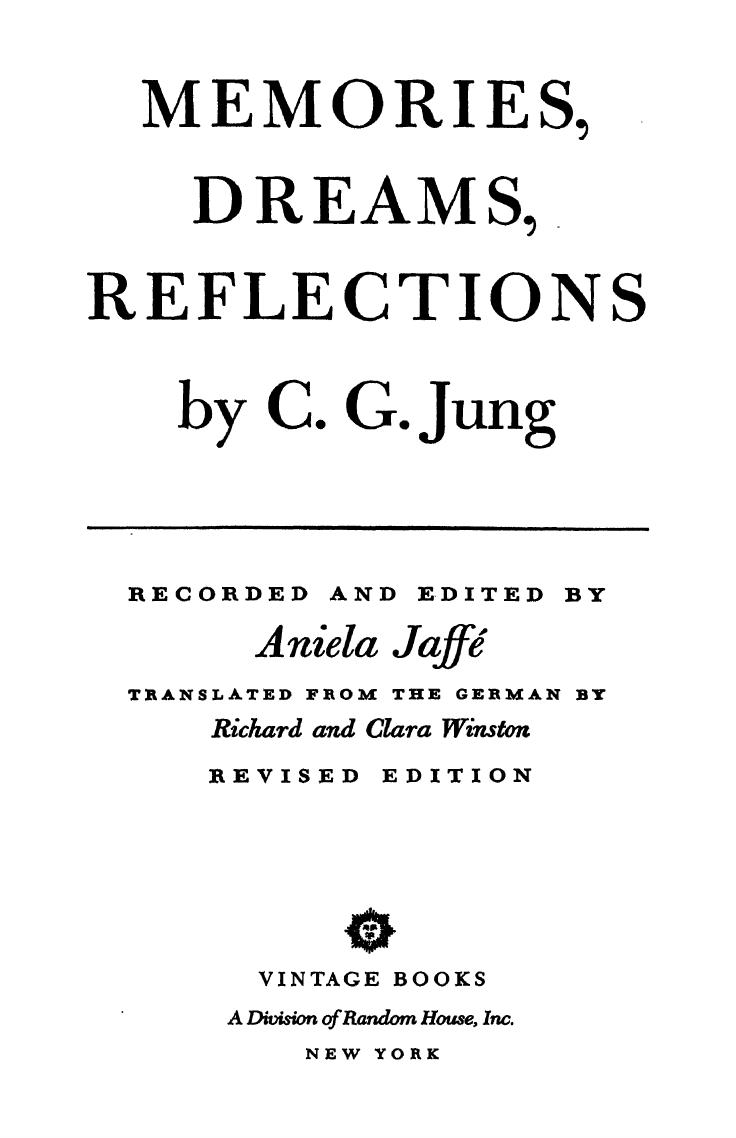Memories, Dreams, Reflections by C.G. Jung

Author:C.G. Jung [Jung, C.G.]
Language: eng
Format: epub, pdf
ISBN: 978-0-307-77271-8
Publisher: Knopf Doubleday Publishing Group
Published: 2011-01-25T16:00:00+00:00
1 Freud speaks of “archaic vestiges.”
2 1957.
3 November 27, 1955.
4 An alchemical treatise ascribed to Thomas Aquinas.
5 The Anthroparion is a tiny man, a kind of homunculus. He is found, for example, in the visions of Zosimos of Panopolis, an important alchemist of the third century. To the group which includes the Anthroparion belong the gnomes, the Dactyls of classical antiquity, and the homunculi of the alchemists. As the spirit of quicksilver, the alchemical Mercurius was also an Anthroparion.—A. J.
6 The Black Book consists of six black-bound, smallish leather notebooks. The Red Book, a folio volume bound in red leather, contains the same fantasies couched in elaborately literary form and language, and set down in calligraphic Gothic script, in the manner of medieval manuscripts.—A. J.
7 Faust, Part One.
8 The Golden (or Homeric) Chain in alchemy is the series of great wise men, beginning with Hermes Trismegistos, which links earth with heaven.—A. J.
9 Privately printed (n.d.) and pseudonymously subtitled “The Seven Sermons to the Dead written by Basilides in Alexandria, the City where the East toucheth the West” (see Appendix V).
10 Faust, Part Two.
11 See above, Chap. V, n. 5, p. 155.
12 During this “fallow period” Jung wrote very little: a handful of papers in English, and the very important first versions of the essays published in English translation as Two Essays on Analytical Psychology (CW 7). The period came to an end with the publication of Psychologische Typen in 1921 (English trans.: Psychological Types, CW 6.)—A.J.
13 Reproduced as the frontispiece to The Archetypes and the Collective Unconscious (CW 9, i).—A. J.
14 Faust, Part Two, trans. by Philip Wayne (Harmondsworth, England, Penguin Books Ltd., 1959), p. 79.
15 Cf. “Concerning Mandala Symbolism,” in The Archetypes and the Collective Unconscious (CW 9, i,), fig. 6 and pp. 363 ff.
16 The Secret of the Golden Flower, fig. 10. See also “Concerning Mandala Symbolism,” fig. 36 and p. 377.
17 On Richard Wilhelm, see Appendix IV.
Download
This site does not store any files on its server. We only index and link to content provided by other sites. Please contact the content providers to delete copyright contents if any and email us, we'll remove relevant links or contents immediately.
Rewire Your Anxious Brain by Catherine M. Pittman(18553)
Talking to Strangers by Malcolm Gladwell(13222)
The Art of Thinking Clearly by Rolf Dobelli(10223)
Mindhunter: Inside the FBI's Elite Serial Crime Unit by John E. Douglas & Mark Olshaker(9201)
Becoming Supernatural by Dr. Joe Dispenza(8119)
Change Your Questions, Change Your Life by Marilee Adams(7635)
Nudge - Improving Decisions about Health, Wealth, and Happiness by Thaler Sunstein(7615)
The Road Less Traveled by M. Scott Peck(7522)
The Lost Art of Listening by Michael P. Nichols(7408)
Enlightenment Now: The Case for Reason, Science, Humanism, and Progress by Steven Pinker(7237)
Mastermind: How to Think Like Sherlock Holmes by Maria Konnikova(7227)
Win Bigly by Scott Adams(7094)
The Way of Zen by Alan W. Watts(6506)
Daring Greatly by Brene Brown(6447)
Big Magic: Creative Living Beyond Fear by Elizabeth Gilbert(5614)
Grit by Angela Duckworth(5523)
Ego Is the Enemy by Ryan Holiday(5294)
Men In Love by Nancy Friday(5157)
Altered Sensations by David Pantalony(5045)
